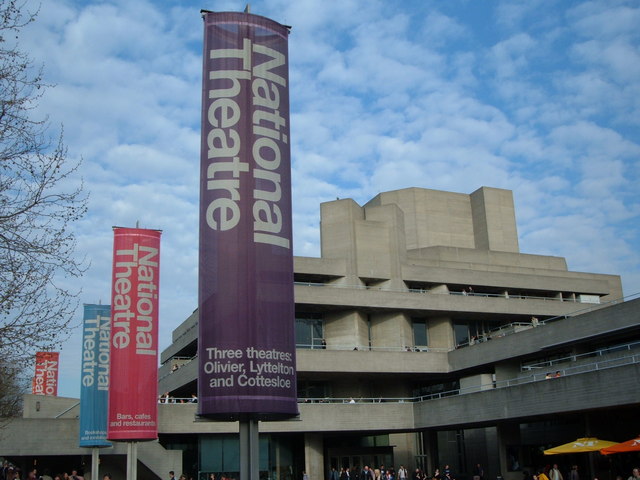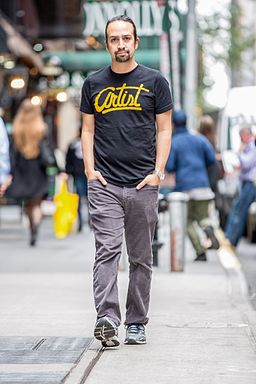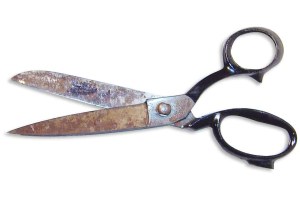I was fortunate recently to see two remarkable productions on the London stage. One was Edward Albee’s Who’s Afraid of Virginia Woolf at the Harold Pinter Theatre, directed by James Macdonald and starring Imelda Staunton, Conleth Hill, Luke Treadaway, and Imogen Poots. The other was Tony Kushner’s Angels In America (both parts, “Millennium Approaches” and “Perestroika”) at the Royal National Theatre, directed by Marianne Elliott and starring Andrew Garfield, Nathan Lane, Denise Gough, and Russell Tovey. The two plays are very different from one another, obviously, but even more than that, the projects undertaken by these two excellent directors in staging these two major works of American drama were strikingly dissimilar.

Photo: The Royal National Theatre, London, in 2005. By Jonathan FeBland, via Wikimedia Commons.
Macdonald’s production of Virginia Woolf was masterfully rooted in realism. Designer Tom Pye’s richly detailed, sunken living-room set was tidy but palpably lived-in. Charles Balfour’s lighting design was nothing short of brilliant in motivating and perfectly coloring every textured pool of light around that room and in walking us through each of the wee hours of the morning and into the cold dawn. Indeed the only visual hint of abstraction was the chilling void beyond George & Martha’s front door, but even this could be interpreted as the effect of real darkness and fog. (I also couldn’t figure out why, when every exit to the kitchen was taken upstage right, George puzzlingly went upstage left to refresh the heavy-drinking characters’ supply of ice cubes, but this hardly seemed an intentional departure from realism, and it’s not impossible to surmise that there might have been a freezer somewhere in the house besides the kitchen.)
As dazzling as Albee’s language is in this, his best-known play, and as flamboyant as Martha’s (and, to a lesser but still significant extent, Nick’s and Honey’s) behavior may be, the acting style was also essentially realistic. Indeed, as great as Imelda Staunton’s performance as Martha truly was, the signal achievement of the evening for me was the far subtler but equally strong work of Conleth Hill as a deliciously wry, long-suffering, sometimes sadistic and sometimes tormented George. His rumpled naturalism epitomized the show.
It was, unsurprisingly, the acting that drew practically all of the critical attention in this rapturously reviewed production. Obsessed as I am with the craft of directing, I found myself ticking off the characteristics of a superb specimen: crackling rhythms and varied pacing, compositions and picturizations making full use of every inch of the stage to tell the story vividly and delight the eye with variety and dynamism, limpid clarity in structure and storytelling, surgical specificity in every circumstance and powerfully motivated action. Best of all, that direction was practically invisible; only a textbook author (or the equivalent) would keep such a scorecard while everyone else in the audience was completely swept up in a harrowing and hilarious story enacted by some of the most compelling performers in the world.
At this point I might mention that on the same trip I saw a major West End production of another Albee play, the vastly inferior The Goat, or Who Is Sylvia? It was gallantly acted by television star Damian Lewis, the great Sophie Okonedo, stalwart Jason Hughes, and the brave, expressive newcomer Archie Madekwe. But the fine director, Ian Rickson, imposed gimmicks, perhaps to draw attention away from the bizarre defects in the strained outrage of a script. (A lot of very smart people disagree with me about the quality of the play: at the time of its 2002 premiere it won Tony and Drama Desk awards and was nominated for a Pulitzer Prize.) For me the most annoying of the tricks played in the show was the movement of the side walls of the scenery, expanding and contracting the width of the room in which the story is set. Why? To give us something to wonder about, other than what piece of crockery poor Ms. Okonedo would be called upon to smash next while screaming “goat f***er!” for the umpteenth time?
It was the complete absence of such foolishness and the quiet assurance of Mr. Macdonald’s seamless direction that made his production of Who’s Afraid of Virginia Woolf? so perfect. He made it look easy, let the play and the actors enjoy the spotlight, and took his satisfaction from disappearing into the work.
My great admiration of this makes me feel somewhat hypocritical that I was a bit disappointed in the direction of “Part One: Millennium Approaches” of Angels in America. Sure, the cast was excellent. I had been a little worried that Lane’s compulsion to provoke laughter might deprive his Roy Cohn of the requisite darkness and (late in the play) fragility, but he was terrific in all those ways (and a pure delight as one of Prior Walter’s ancestors). Garfield’s performance as Prior started out perhaps too arch but then proved intelligent, funny, and moving. Gough had not gotten good reviews as Harper Pitt but she acquitted herself well. Tovey‘s performance as Joe Pitt was the most honest and natural of all. The rest of the cast was equally excellent. The story was told with clarity and some visual flair as colorfully neon-framed turntables moved us from locale to locale in Kushner’s cinematic/Shakespearean/surrealistic scene structure. But it was all just a bit more straightforward than I had hoped.
You see, this was not just a chance to see my favorite play live onstage for the first time in more than 20 years, and not just a chance to see it with an all-star cast. This was a chance to see it interpreted by a mega-star director, Marianne Elliott, who had co-directed War Horse (Olivier nomination and Tony Award) and directed The Curious Incident of the Dog in the Night-Time (Olivier Award and Tony Award). Curious Incident in the West End had, as a matter of fact, provided the most exciting night I’d spent in a theatre since first seeing Angels in 1994, because for the first time I saw the latest scenographic technology and some eye-opening experimental movement employed in the service of a story I really cared about. The puppetry in War Horse was also revolutionary. By the time of the dinner break between Angels Parts One and Two, though, there had been no such directorial excitement.
Or, rather, there had been only one moment of it: The final imagery of the four-hour first part was the arrival of the Angel, not from the theatre’s fly space but rising up out of what seemed to be dark, amorphous creatures that swirled like scraps of ash. Here were the visuals, the puppetry, the abstract movement that had marked Ms. Elliott’s brilliant earlier work. This would become the touchstone for the style of Part Two, and although the neon and mechanically moving playing spaces returned as touches (and although I’m not sure that the way Elliott’s Angel appeared is the way that Kushner’s writing calls for it to appear), this darker, more experimental and more directorially assertive style made me feel that the production as a whole had been worth a trip to London.
As “Perestroika” unfolded, the dark figures of the ensemble, moving low to the ground like insects or crustaceans while somehow evoking Erinyes, began to change the scenes, to lurk in the shadows of the earthly settings, and to hold and manipulate the Angel’s wings (only to become anonymous members of the council of wingless angels that Prior confronts in heaven). In the scene within the Mormon Visitors Center, the director’s facility with puppetry brought the animatronic figures to life in a uniquely creative way. The heaven setting stripped most of the masking out of the yawning Lyttleton stage house leaving only an abstract curving frame structure that had gradually been emerging from the upstage shadows since early in Part One. The actors’ performances were in no way diminished (in fact Lane, among others, just seemed to get better and better) and Kushner’s text was in no way neglected, but Elliott’s confident interpretation, distinctive propensities, and kinesthetic visual flair moved into the foreground.
What the two productions had in common was not insignificant: a major investment in the most skilled and authentic work of some of the best actors on the planet, and a deep, detailed interest in the best writing of two of America’s greatest playwrights. Yet one director set out to give his production as inconspicuous a shape as possible, while the other sought a distinctive and original approach that would establish a whole new vision of an iconic play. It is important to note that Albee’s play is written to be performed in a particular way, and that at the time of the author’s death he had made it abundantly clear that he was not open to rangy reinterpretations. It is also salient that Kushner not only welcomed the idea of an Elliott-led mounting of his masterpiece (presumably knowing her reputation and probably having seen her high-profile shows) but that he also participated extensively in the process of the production’s development. Regardless, it is intriguing to ponder how disparate the director’s work can be, even in its goals, from play to play and from production to production.
Who’s Afraid of Virginia Woolf was broadcast live and video recorded for encore presentations that continue now in cinemas around the world, including showings today (Sunday, June 18, 2017). Angels In America, “Part One: Millennium Approaches” will be broadcast live on July 20, 2017 and “Part Two: Perestroika” will follow on July 27 in cinemas around the globe. Visit the National Theatre Live online to find movie theatres that will be showing these video presentations.
Angels in America, with Garfield, Lane, Hough, and most of the rest of the London cast (sans Russell Tovey) still in place, starts previews on Broadway on February 23.

 In December of last year I learned, via
In December of last year I learned, via